Why doesn't my Honeywell TB6575B1000/U - SuitePro Digital Fan Coil Stat Thermostat fan turn on when heating?
- AAmber MurphySep 10, 2025
There may be a wiring or connection failure. Check the wiring and ensure the connection is correct.
Why doesn't my Honeywell TB6575B1000/U - SuitePro Digital Fan Coil Stat Thermostat fan turn on when heating?
There may be a wiring or connection failure. Check the wiring and ensure the connection is correct.
Why is my Honeywell Thermostat heat not turning on?
This could be due to heating equipment failure or a loose connection/broken wire. * For TB6575A/B: Check for 120/240 Vac at the equipment between power and common (L and N), and between the heat (W) and common (N) terminals. If voltage is present, the thermostat is functional. * For TB8575A: Check for 24 Vac at the equipment on the secondary side of the transformer between power and common (R and C), and between the heat terminal (W) and transformer common. If voltage is present, the thermostat is functional. If voltage is not present, check the wire connection (loose or broken) between the thermostat and the heating equipment.
Why is my Honeywell TB6575B1000/U - SuitePro Digital Fan Coil Stat cooling not turning on?
This issue can occur due to cooling equipment failure or a loose/broken wire. * For TB6575A/B: Check for 120/240 Vac at the equipment between power and common (L and N), and between the cool (Y) and common (N) terminals. If voltage is present, the thermostat is functional. * For TB875A: Check for 24 Vac at the equipment on the secondary side of the transformer between power and common (R and C), and between the cool terminal (Y) and transformer common. If voltage is present, the thermostat is functional. If voltage is not present, check the wire connection (loose or broken) between the thermostat and the cooling equipment.
What to do if my Honeywell TB6575B1000/U - SuitePro Digital Fan Coil Stat temperature settings do not change?
This may happen if the upper or lower temperature limits have been reached. Check the temperature setpoints for heating and cooling (Installer Setup codes 16 and 17 respectively) and modify them as needed. Alternatively, the keypad may be fully locked. In this case, change the keypad locked options (Installer Setup code #18).
Why does my Honeywell Thermostat remote sensor not display temperatures?
The issue might be due to an incorrect ISU code or an incompatible sensor. Set the Installer Setup code #4 to Remote (value = 1). Also, the remote sensor must be a TR21 or a compatible 20K NTC.
Why is my Honeywell TB6575B1000/U - SuitePro Digital Fan Coil Stat calling for heat or cool but nothing is happening?
The heating or cooling equipment might not be operating. Check the wiring and ensure the Installer Setup code #2 (System Type) matches the installed heating and/or cooling equipment. You can verify the operation of the equipment in Installer Test mode.
Why doesn't my Honeywell TB6575B1000/U - SuitePro Digital Fan Coil Stat Thermostat auto fan reset activate?
The issue could be due to an incorrect ISU code or the call for Heat/Cool setpoint not being satisfied. Set the Installer Setup code #24 to Enabled (value = 1 or 2). The auto fan reset timer will only activate after the setpoint is satisfied.
Why can't I select the fan speed on my Honeywell Thermostat?
The Fan Control Type selection might be incorrect. Check that the Installer Setup code #9 (Fan Control) value is set to zero (0).
Why is Cool On not showing on my Honeywell Thermostat display?
The System Type setting might not be set to Cool, or the temperature setting is not set below the room temperature. Set the Installer Setup code #2 to Cool and set the temperature setting below the room temperature.
Why won't my Honeywell TB6575B1000/U - SuitePro Digital Fan Coil Stat let me set the system to cool?
The System Type (Installer Setup code #2) might be set to Heat Only (value = 0). Set the Installer Setup code #2 value to match the installed heating and/or cooling equipment.
Highlights the thermostat's user-friendly interface and advanced capabilities.
Lists the sections and corresponding page numbers of the manual.
Details the required AC voltage inputs for the thermostats.
Provides current ratings for fan and heat/cool relays.
Specifies operating temperature and humidity limits.
Describes the internal sensor's type, range, and accuracy.
Details the optional remote sensor's specifications.
Details the optional pipe sensor's specifications.
Describes the input for remote setback functionality.
Defines the temperature limits for setback modes.
Describes the physical casing of the thermostat.
Explains methods for mounting the thermostat to junction boxes.
Details terminal compatibility for different wire gauges.
Specifies the lifespan of the thermostat's contacts.
Lists relevant safety and regulatory certifications.
Lists optional accessories available for the thermostat.
Provides crucial pre-installation checks and installer qualifications.
Alerts to the risk of severe injury or death from electrical shock.
Highlights critical information regarding line voltage and transformer requirements.
Guides on selecting an optimal placement for accurate room sensing.
Covers the physical mounting process and initial wiring connections.
Warns about potential damage to the unit from low operating temperatures.
Explains the function and identification of each terminal.
Defines common terminal labels used in wiring diagrams.
Provides instructions for connecting and configuring the remote pipe sensor.
Details how to wire and use an optional remote temperature sensor.
Emphasizes safety precautions regarding electrical shock during servicing.
Warns about potential operational issues due to electrical interference.
Stresses compliance with electrical codes and wiring practices.
Illustrates wiring configurations for temperature averaging networks.
Presents wiring diagrams for 120/240 Vac models.
Diagram for a 2-pipe heat-only configuration at 120/240 Vac.
Diagram for a 2-pipe cool-only configuration at 120/240 Vac.
Diagram for a 2-pipe manual changeover at 120/240 Vac.
Diagram for a 2-pipe auto changeover at 120/240 Vac.
Diagram for a 4-pipe manual/auto changeover at 120/240 Vac.
Diagram for a 2-pipe w/ aux heat manual changeover at 120/240 Vac.
Diagram for electromechanical retrofit wiring on 120/240 Vac systems.
Diagram for a 2-pipe heat-only configuration at 24 Vac.
Diagram for a 2-pipe cool-only configuration at 24 Vac.
Diagram for a 2-pipe manual changeover at 24 Vac.
Diagram for a 2-pipe auto changeover at 24 Vac.
Diagram for a 4-pipe manual/auto changeover at 24 Vac.
Diagram for a 2-pipe w/ aux heat manual changeover at 24 Vac.
Diagram for electromechanical retrofit wiring on 24 Vac systems.
Provides step-by-step instructions for safely removing the thermostat.
Reiterates the risk of electrical shock when servicing.
Warns against improper removal that could damage the unit.
Describes the thermostat's behavior upon initial power application.
Warns that power overload can damage the thermostat.
Details how to access and navigate the installer setup menu.
Illustrates the screen layout for Installer Setup Mode.
Lists configuration codes and their available settings.
Allows selection of 120 Vac or 240 Vac power supply.
Configures the thermostat for specific system types (e.g., 2-pipe, 4-pipe).
Controls fan behavior when auxiliary heat is active.
Determines how the valve operates for heating or cooling calls.
Specifies whether to use the onboard or a remote sensor.
Enables pipe sensor input for specific system types.
Sets the temperature threshold for pipe sensor-based cooling changeover.
Sets the temperature threshold for pipe sensor-based heating changeover.
Selects between Fahrenheit and Celsius display.
Configures the initial fan speed upon startup for torque.
Sets the number of available fan speeds (1, 2, or 3).
Selects fan control method: Constant, Auto, or VersaSpeed™.
Defines control strategy for 4-pipe auto changeover systems.
Sets the deadband between heating and cooling setpoints.
Adjusts differential for single setpoint control.
Sets the maximum cycles per hour for heating.
Sets the maximum cycles per hour for auxiliary heat.
Allows adjustment of the displayed temperature.
Chooses what information is displayed on the LCD.
Limits the maximum heating setpoint.
Limits the minimum cooling setpoint.
Enables or disables keypad functions.
Configures remote setback options, including hotel card integration.
Sets the setback temperature for heating mode.
Sets the setback temperature for cooling mode.
Enables or disables automatic setback based on inactivity.
Activates a safety feature to prevent freezing.
Configures automatic fan reset to Auto mode.
Details how to enter and use the installer test mode.
Explains the thermostat's advanced control algorithm for precise regulation.
Describes different methods for activating economy setback.
Details how inactivity triggers economy setback.
Explains setback activation via the System button.
Describes setback activation via external dry contact inputs.
Details how economy setback affects setpoints and deadbands.
Details the auto fan reset feature and its configuration.
Overviews various application modes supported by the thermostat.
Explains requirements for 2-pipe systems with seasonal changeover.
Details operation for 2-pipe auto changeover systems.
Details operation for 2-pipe systems with auxiliary heat.
Describes different fan operating modes and settings.
Explains the fan ramping algorithm for speed selection.
Details the purge cycle process for seasonal changeover systems.
Explains operation for 4-pipe auto changeover systems.
Describes control strategy for 4-pipe auto changeover with a single setpoint.
Describes control strategy for 4-pipe auto changeover with separate setpoints.
Troubleshooting steps for a blank thermostat display.
Steps to resolve issues with temperature setting changes.
Diagnoses why heating or cooling might not activate.
Troubleshooting when thermostat calls but equipment doesn't run.
Steps to diagnose why heating fails to turn on.
Troubleshooting concurrent heating and cooling operation.
Steps to diagnose why cooling fails to turn on.
Troubleshooting wire connection issues with cooling equipment.
Diagnoses why the fan fails to operate during a heat call.
Troubleshooting issues with selecting fan speeds.
Diagnoses why heating operates when cooling is called.
Troubleshooting heating not shutting off when set below room temp.
Resolves inability to set the system to Heat mode.
Resolves inability to set the system to Cool mode.
Troubleshooting why the 'Heat On' indicator is absent.
Troubleshooting why the 'Cool On' indicator is absent.
Diagnoses issues with remote sensor temperature readings.
Troubleshooting why remote setback is not functioning.
Resolves activity sensing not exiting upon button press.
Troubleshooting why freeze protection is not engaging.
Diagnoses why the auto fan reset feature is not working.
Highlights the thermostat's user-friendly interface and advanced capabilities.
Lists the sections and corresponding page numbers of the manual.
Details the required AC voltage inputs for the thermostats.
Provides current ratings for fan and heat/cool relays.
Specifies operating temperature and humidity limits.
Describes the internal sensor's type, range, and accuracy.
Details the optional remote sensor's specifications.
Details the optional pipe sensor's specifications.
Describes the input for remote setback functionality.
Defines the temperature limits for setback modes.
Describes the physical casing of the thermostat.
Explains methods for mounting the thermostat to junction boxes.
Details terminal compatibility for different wire gauges.
Specifies the lifespan of the thermostat's contacts.
Lists relevant safety and regulatory certifications.
Lists optional accessories available for the thermostat.
Provides crucial pre-installation checks and installer qualifications.
Alerts to the risk of severe injury or death from electrical shock.
Highlights critical information regarding line voltage and transformer requirements.
Guides on selecting an optimal placement for accurate room sensing.
Covers the physical mounting process and initial wiring connections.
Warns about potential damage to the unit from low operating temperatures.
Explains the function and identification of each terminal.
Defines common terminal labels used in wiring diagrams.
Provides instructions for connecting and configuring the remote pipe sensor.
Details how to wire and use an optional remote temperature sensor.
Emphasizes safety precautions regarding electrical shock during servicing.
Warns about potential operational issues due to electrical interference.
Stresses compliance with electrical codes and wiring practices.
Illustrates wiring configurations for temperature averaging networks.
Presents wiring diagrams for 120/240 Vac models.
Diagram for a 2-pipe heat-only configuration at 120/240 Vac.
Diagram for a 2-pipe cool-only configuration at 120/240 Vac.
Diagram for a 2-pipe manual changeover at 120/240 Vac.
Diagram for a 2-pipe auto changeover at 120/240 Vac.
Diagram for a 4-pipe manual/auto changeover at 120/240 Vac.
Diagram for a 2-pipe w/ aux heat manual changeover at 120/240 Vac.
Diagram for electromechanical retrofit wiring on 120/240 Vac systems.
Diagram for a 2-pipe heat-only configuration at 24 Vac.
Diagram for a 2-pipe cool-only configuration at 24 Vac.
Diagram for a 2-pipe manual changeover at 24 Vac.
Diagram for a 2-pipe auto changeover at 24 Vac.
Diagram for a 4-pipe manual/auto changeover at 24 Vac.
Diagram for a 2-pipe w/ aux heat manual changeover at 24 Vac.
Diagram for electromechanical retrofit wiring on 24 Vac systems.
Provides step-by-step instructions for safely removing the thermostat.
Reiterates the risk of electrical shock when servicing.
Warns against improper removal that could damage the unit.
Describes the thermostat's behavior upon initial power application.
Warns that power overload can damage the thermostat.
Details how to access and navigate the installer setup menu.
Illustrates the screen layout for Installer Setup Mode.
Lists configuration codes and their available settings.
Allows selection of 120 Vac or 240 Vac power supply.
Configures the thermostat for specific system types (e.g., 2-pipe, 4-pipe).
Controls fan behavior when auxiliary heat is active.
Determines how the valve operates for heating or cooling calls.
Specifies whether to use the onboard or a remote sensor.
Enables pipe sensor input for specific system types.
Sets the temperature threshold for pipe sensor-based cooling changeover.
Sets the temperature threshold for pipe sensor-based heating changeover.
Selects between Fahrenheit and Celsius display.
Configures the initial fan speed upon startup for torque.
Sets the number of available fan speeds (1, 2, or 3).
Selects fan control method: Constant, Auto, or VersaSpeed™.
Defines control strategy for 4-pipe auto changeover systems.
Sets the deadband between heating and cooling setpoints.
Adjusts differential for single setpoint control.
Sets the maximum cycles per hour for heating.
Sets the maximum cycles per hour for auxiliary heat.
Allows adjustment of the displayed temperature.
Chooses what information is displayed on the LCD.
Limits the maximum heating setpoint.
Limits the minimum cooling setpoint.
Enables or disables keypad functions.
Configures remote setback options, including hotel card integration.
Sets the setback temperature for heating mode.
Sets the setback temperature for cooling mode.
Enables or disables automatic setback based on inactivity.
Activates a safety feature to prevent freezing.
Configures automatic fan reset to Auto mode.
Details how to enter and use the installer test mode.
Explains the thermostat's advanced control algorithm for precise regulation.
Describes different methods for activating economy setback.
Details how inactivity triggers economy setback.
Explains setback activation via the System button.
Describes setback activation via external dry contact inputs.
Details how economy setback affects setpoints and deadbands.
Details the auto fan reset feature and its configuration.
Overviews various application modes supported by the thermostat.
Explains requirements for 2-pipe systems with seasonal changeover.
Details operation for 2-pipe auto changeover systems.
Details operation for 2-pipe systems with auxiliary heat.
Describes different fan operating modes and settings.
Explains the fan ramping algorithm for speed selection.
Details the purge cycle process for seasonal changeover systems.
Explains operation for 4-pipe auto changeover systems.
Describes control strategy for 4-pipe auto changeover with a single setpoint.
Describes control strategy for 4-pipe auto changeover with separate setpoints.
Troubleshooting steps for a blank thermostat display.
Steps to resolve issues with temperature setting changes.
Diagnoses why heating or cooling might not activate.
Troubleshooting when thermostat calls but equipment doesn't run.
Steps to diagnose why heating fails to turn on.
Troubleshooting concurrent heating and cooling operation.
Steps to diagnose why cooling fails to turn on.
Troubleshooting wire connection issues with cooling equipment.
Diagnoses why the fan fails to operate during a heat call.
Troubleshooting issues with selecting fan speeds.
Diagnoses why heating operates when cooling is called.
Troubleshooting heating not shutting off when set below room temp.
Resolves inability to set the system to Heat mode.
Resolves inability to set the system to Cool mode.
Troubleshooting why the 'Heat On' indicator is absent.
Troubleshooting why the 'Cool On' indicator is absent.
Diagnoses issues with remote sensor temperature readings.
Troubleshooting why remote setback is not functioning.
Resolves activity sensing not exiting upon button press.
Troubleshooting why freeze protection is not engaging.
Diagnoses why the auto fan reset feature is not working.
| Application | Fan Coil Units |
|---|---|
| Display | LCD |
| Accuracy | ±1°F |
| Protection Rating | IP20 |
| Type | Digital |
| Voltage | 24 VAC |
| Operating Humidity Range (% RH) | 5 to 90% RH |
| Operating Temperature Range (F) | 32 to 122 F |
| Operating Temperature Range (C) | 0 to 50°C |
| Temperature Range | 40 to 90 F |
| Mounting | Wall Mount |
| Control | Digital |
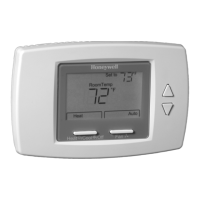
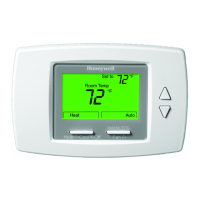
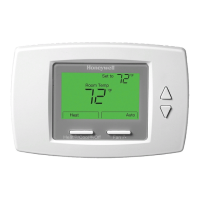
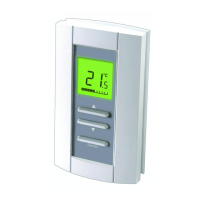
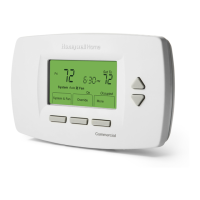
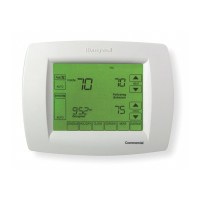
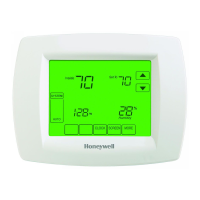


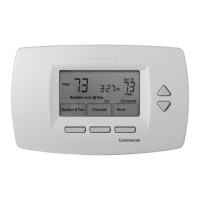
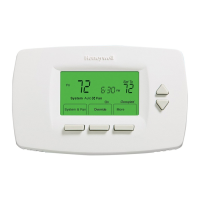
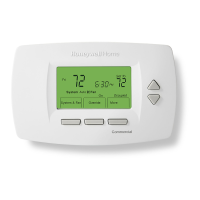
